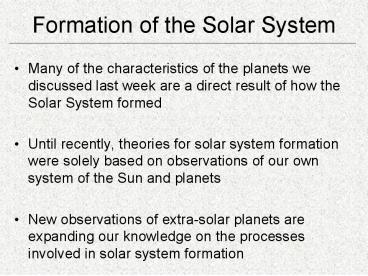Formation of the Solar System - PowerPoint PPT Presentation
Title:
Formation of the Solar System
Description:
Most of the moons in the Solar System orbit their planets in a counter ... The theory begins with a cloud of gas and dust from which the Solar System can form ... – PowerPoint PPT presentation
Number of Views:57
Avg rating:3.0/5.0
Title: Formation of the Solar System
1
Formation of the Solar System
- Many of the characteristics of the planets we
discussed last week are a direct result of how
the Solar System formed - Until recently, theories for solar system
formation were solely based on observations of
our own system of the Sun and planets - New observations of extra-solar planets are
expanding our knowledge on the processes involved
in solar system formation
2
What We Know
- The planets are spaced relatively far from each
other (no clumps or groups) - _
- The orbits of the planets around the Sun all lie
nearly in the same plane - _
- The rotation of the planets on their axis is
usually the same direction (counter-clockwise) as
their orbit around the Sun
3
What We Know
- Most of the moons in the Solar System orbit their
planets in a counter-clockwise fashion - _
- Asteroids orbit the Sun similar to the planets,
but do not share characteristics with either the
terrestrial or jovian planets - _
- The Oort Cloud contains small icy fragments that
are distributed in a shell around the Solar System
4
The Explanation
- Astronomers have spent a lot of time and effort
seeking a theory to explain all ten of the
previous observations - The theory begins with a cloud of gas and dust
from which the Solar System can form - The galaxy is full of many such clouds,
detectable by the light they obscure
New young stars
Dark gas cloud
5
Nebular Contraction
- Something must first trigger the gas cloud to
collapse - Nearby supernova
- Collision of two clouds
- _
- In addition, as the cloud shrinks, it will begin
to rotate faster and faster, due to conservation
of angular momentum
6
Conservation of Angular Momentum
- Many physical quantities in nature must be
conserved - Mass, energy, and angular momentum cannot be
created or destroyed, but can be transferred from
one form to another - _
7
A Spinning Disk
- As the cloud contracts, it spins faster and
faster - _
- Eventually, the majority of the gas and dust is
concentrated into a disk
8
Condensation and Accretion
- The central portion of the disk with continue to
shrink until a star is formed - _
- Small particles of dust begin to collide with
each other, becoming larger and larger - _
9
Collisions
- Eventually, objects grow to the size of small
proto-planets - _
- Occasionally, two proto-planets can collide to
form a new larger body
10
Formation of the Inner Planets
11
The Role of Temperature
- As the planets were forming, there was a wide
range of temperatures in the solar nebula - _
- Closer toward the Sun, only metals were able to
survive the high temperatures - _
12
The Role of Temperature
- Mercury, forming very close to the Sun, is
comprised mainly of metals, like iron - _
- In addition to hydrogen and helium gas, the outer
planets have high amounts of water and ammonia
ice - _
13
Where Did the Gas Come From?
- The solar nebula was full of gas, so why did only
the four outer planets capture huge amounts? - _
- These cores began to sweep up nearby gas (mainly
hydrogen and helium) very early - _
14
Formation of the Outer Planets
15
Solar System Debris
- While small bodies were colliding and accreting
in the Solar System, many objects were also
ejected to more distant orbits - _
- In the inner Solar System, small bodies were
ejected out to an orbit between Mars and Jupiter,
forming the asteroid belt - _
16
Kuiper Belt and the Oort Cloud
Early after Gas Giant Formation
After Smaller Bodies Ejected
17
How Did We Do?
?
- The planets are spaced relative far from each
other (no clumps or groups) - _
- The orbits of the planets around the Sun all lie
nearly in the same plane - _
- The rotation of the planets on their axis is
usually the same direction (counter-clockwise) as
their orbit around the Sun
?
?
?
?
18
How Did We Do?
?
- Most of the moons in the Solar System orbit their
planets in a counter-clockwise fashion - _
- Asteroids orbit the Sun similar to the planets,
but do not share characteristics with either the
terrestrial or jovian planets - The Kuiper belt contains a large collection of
icy objects outside the orbit of Neptune - _
?
?
?
?
19
What About the Exceptions?
- There are a few objects in the Solar System which
do not follow the 10 observations we listed - _
- Uranus' axis is tilted by more than 90o
- A glancing collision early in its history could
have knocked Uranus on its side
20
Formation of Earth's Moon
- It is also believed that a collision between
proto-Earth and a Mars-sized proto-planet created
our Moon - Computer models can reproduced this situation
- _































